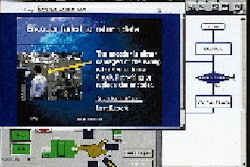Who says employees can't be motivated to work harder and smarter? Experts on personnel management have developed proven techniques to inspire top performance that can lead to superior work habits, happier customers and fatter bottom-line profits. "Top managers realize that in a tight labor market, it's cheaper to concentrate on retention than to live with high turnover," says Don Schackne, president of Personnel Management and Administration Associates, Delaware, OH. "When an employee walks out the door, you lose all your invested training dollars and productivity. Starting over with a new employee is very expensive and creates morale problems." Is the secret to boost salaries? Not in the long run. "Paying more money isn't the answer," Schackne contends. "You may steal a few employees from the competition that way, but you can raise your cost of doing business to a level that cannot be passed on to your customers." With tighter profit margins, businesses may find it difficult to motivate by fattening the workers' wallets. Experts point to this secret of motivation: Build employees' human potential. Show them how working at the company can increase their skills and propel them forward in their career path. "Effective management of employees has the purpose of helping individuals achieve to their maximum abilities, resiliently and independently," says Dr. Peter A. Spevak, director of the Center for Applied Motivation, Rockville, MD. "This results in an activated, responsible workforce that through its efforts provides meaning, as well as income, for each individual employee, and for the business." How can management help bring about this profitable situation? Here are seven steps: 1. Relate employee goals to the business's goals. 2. Provide individual feedback. 3. Provide career counseling. 4. Teach employees other job functions. 5. Involve employees in planning. 6. Involve employees in motivating the team. 7. Try new motivational methods. Relating goals to the business If employees don't feel as though they are vital elements to the success of the business, they will not perform to their peak abilities, nor will they seek out additional ways to become more productive. Sometimes managers act as though employees have nothing to do with the end result of the business. Yet they expect the employees to contribute to the business's success. It's important to inform employees of the ultimate goal of the business: to make a good profit. Share the actual numbers with them. How much does the business need to make in profit to be successful? How do the actions of each employee contribute to that profit? Then explain why a more profitable business is in the best interests of the employee. Show how a stronger bottom line will lead to greater salaries and bonuses, as well as insurance against layoffs. Describe the company's plan for sharing part of increased profits with everyone. Notice how this two-step effort assists employees in identifying their personal goals and rewards with those of the business. This is a much better approach than telling the employees that the ultimate goal of the business is to serve the customer. While good service does lead to better profits, it is not the ultimate goal. Get everyone's eye on the same target: the bottom line. Provide feedback Once employees understand the business goal, make sure each one knows how individual tasks help the business achieve greater profit. For example, when an associate types a letter without mistakes, the recipient is impressed, the company's image is enhanced and more orders are apt to be forthcoming. Employees need more than a sense that they'll be rewarded in monetary terms as they help the business succeed. They also need to know that their work is worthwhile, that it creates value. Establish a regular program of providing performance feedback to each employee. Keep an eye open for actions that reflect excellence, or that show the employee is going beyond the defined parameters of the job to do better work. Then praise the employee for that specific work. Don't just say that the employee is doing a great job. Identify exactly what was done well and then tell the employee how pleased the company is that particular actions were taken: perhaps the worker stayed an extra two hours to finish an important task. Second, provide such feedback in a structured way. Invite each employee into a manager's office on a regular basis and discuss especially good accomplishments. This will motivate the employee more than will spontaneous expressions of appreciation at the work site. These often seem to be insincere, or without real feeling-and they will not motivate. Provide career counseling So far, we've covered how to motivate employees to relate the ultimate business goal of profit to their individual goals of more money and greater self-worth. That can be considered "short-term" thinking. Now let's turn to longer-term motivation. In individual meetings, management needs to communicate to employees a concern with the individual's long-term career goals, and that the work they are doing will help them achieve their aspirations. Request feedback from employees on how the business can provide them with greater opportunities for advancing toward their career goals. Encourage employees to suggest ways in which they can further their skills while boosting company profits. Can their work be done in a better way, perhaps more productively, or can some tasks be delegated to newer or lower-level employees? What additional tasks can the employee take on that will expand abilities? Encourage employees to take continuing education courses and read books that will help them acquire more skills. A minimum budget in this area can make sure everyone participates, and a maximum budget can keep costs from getting out of line. Teach employees others' jobs Everyone should know what specific tasks are accomplished by other company members. Only by knowing this will the employee realize how individual actions contribute toward a functioning, profitable company. "If you give people training, you let them know they are valuable," says Spevak. "By all means teach them how to interact with the customers." Are all of the suggestions mentioned above in place at the company? If so, then it's time to move into high gear. Involve employees in planning for greater business success. That will help the company develop into a powerhouse that others will find hard to beat. "With the tighter labor market, employers are starting to realize they better listen to their employees," says Schackne. "How do they feel about the place? The management style?" Written surveys can be done on an anonymous basis, points out Schackne. This encourages people to open up. "An employee attitude survey is the best way to identify what areas may be hindering your business's effectiveness," he says. "Use surveys to explore your organization and management image, compensation, communications, work requirements, job security and many other areas." Schackne suggests including an essay question so the employees can say whatever they want. "Keep the entire survey anonymous, so participants will not feel threatened with reprisal," he adds. Another way to involve employees in planning the business is to hold regular staff meetings during which employees discuss steps the business can take to become more profitable. How can tasks be changed so that work becomes more productive? Into what new areas can the business move? What problems are likely to arise and what can the business do to avoid them, or lessen their effects? What are customers saying about the good and bad points of the business? The trick here is to set goals that are clearly defined in concrete terms. In discussing profits, provide a certain net income number as the goal. Make sure the goals are achievable. Avoid the two most common problems in setting goals: Creating too many goals, and scheduling insufficient time to achieve the goals. Involve employees A manager has no way of knowing what will motivate an employee until he or she has spoken with each one, both individually and as part of a group discussion. With each employee, hold twice-annual reviews in which specific, concrete goals are set. For example: "Find two ways to increase the productivity of your job over the next six months." During these reviews go over the specific goals from the last review and see which ones the employee managed to achieve. Discuss those that were not achieved and make plans for achieving them during the next six months. Don't get caught in a rut. Always be on the lookout for new techniques that will get employees working with management to create a valuable business that out-performs the competition and keeps raking in profits year after year. Flexible work hours is one example. Employees are given longer weekends, or greater flexibility in scheduling vacation time. The idea is to boost morale and productivity. A related technique is to allow employees to "buy" and "sell" vacation days with their co-workers. Others are using suggestion boxes. While this sometimes proves effective, don't let it become a substitute for individual and group communication. Still others are developing award programs for performance in areas as various as sales and safety. Employees accumulate points for performance. When they collect a certain number of points, they turn them in for a reward-usually some gift item that costs from $10 to $100. Above all, gear everything toward encouraging the employee to create individual incentives to work more productively. Involve the employee as much as possible in the actual planning and running of the business. If the employees feel they are going somewhere in your business, they won't need to be pushed. Phillip M. Perry is an award-winning journalist specializing in business management and law. He has written more than 3ꯠ articles for a variety of publications. He may be reached at 212/274-8694, or via E-mail: [email protected]


























